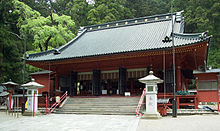Nikkō Futarasan-Schrein
Der Nikkō Futarasan-Schrein (jap. 日光二荒山神社, Nikkō Futarasan-jinja) in Sannai, Nikkō in der Präfektur Tochigi (Japan) ist ein Shintō-Schrein. Der offizielle Name ist Futarasan-Schrein (二荒山神社), allerdings wird wegen des identisch geschriebenen Futaarayama-Schreins in der Nachbarstadt Utsunomiya üblicherweise beiden der Ortsname vorangestellt.
Dieser Schrein ist zusammen mit weiteren Schreinen und Tempeln in Sannai wie dem Rinnō-ji oder Tōshō-gū Teil des UNESCO-Weltkulturerbes.
Der Schrein ist den Kami dreier Berge gewidmet: Nantai-san, Nyohō-san und Tarō-san. Sie heißen
- Ōnamuchi no mikoto (der Gott, der dieses Land geschaffen haben soll)
- Tagorihime no mikoto (eine seiner Frauen)
- Ajisukitakahikone no mikoto (beider Sohn und ein Kami der Landwirtschaft).
Die Gebetshalle des Schreins (Haiden) ist sehr schlicht und einfach gestaltet. Dahinter steht mit der Haupthalle des Schreins (Honden) aus dem Jahre 1619 das älteste Gebäude in Sannai.
Eine Quelle am Honden mit dem Namen Futara Reisen soll zwei verschiedene Wässer spenden: die eine wird Sake no izumi genannt, also Sake-Quelle. Die zweite wird als Chie no izumi („Quelle der Weisheit“) genannt. Das Trinken des Wassers soll gegen das Alter und schlechtes Sehvermögen helfen.[1]
Weitere Sehenswürdigkeiten des Schreins sind das Eingangstor im chinesischen Stil (Karamon), ein aus Bronze gefertigtes Torii und eine hölzerne Bogenbrücke.
Fotos
Einzelbelege
Weblinks
- Website des Schreins – Japanisch
- Schreine und Tempel von Nikko auf der Weltkulturerbeseite der UNESCO – Englisch
Koordinaten: 36° 45′ 30″ N, 139° 35′ 47″ O
Auf dieser Seite verwendete Medien
This photograph shows a building, the Hie Shrine, at Futarasan Jinja 二荒山神社 in Nikko, Tochigi Prefecture, Japan. I took the photograph and contribute my rights in the file to the public domain; individuals and organizations retain rights to images in it.
The building beyond the wall is the honden, or main hall, of Futarasan Shrine in Nikko, Tochigi Prefecture, Japan. The shrine is a UNESCO World Heritage Site. I took this photo and contribute my rights in the file to the public domain; individuals and organizations retain rights to images in it.
This photograph shows a building, the Daikoku-den (大黒殿) at Futarasan Jinja 二荒山神社 in Nikko, Tochigi Prefecture, Japan. I took the photograph and contribute my rights in the file to the public domain; individuals and organizations retain rights to images in it.
This photograph shows a gate at Futarasan Jinja 二荒山神社 in Nikko, Tochigi Prefecture, Japan. I took the photograph and contribute my rights in the file to the public domain; individuals and organizations retain rights to images in it.
This photograph shows a building, the Mitomo Jinja, at Futarasan Jinja 二荒山神社 in Nikko, Tochigi Prefecture, Japan. I took the photograph and contribute my rights in the file to the public domain; individuals and organizations retain rights to images in it.
This photograph shows building at Futarasan Jinja 二荒山神社 in Nikko, Tochigi Prefecture, Japan. I took the photograph and contribute my rights in the file to the public domain; individuals and organizations retain rights to images in it.
This photograph shows a building (probably the haiden 拝殿) at Futarasan Jinja 二荒山神社 in Nikko, Tochigi Prefecture, Japan. I took the photograph and contribute my rights in the file to the public domain; individuals and organizations retain rights to images in it.
This photograph shows the Chinese-style lantern, popularly called Bake-doro (the "Ghost Lantern"), at Futarasan Jinja 二荒山神社 in Nikko, Tochigi Prefecture, Japan. I took the photograph and contribute my rights in the file to the public domain; individuals and organizations retain rights to images in it.
This photograph shows a building that houses the mikoshi at Futarasan Jinja 二荒山神社 in Nikko, Tochigi Prefecture, Japan. I took the photograph and contribute my rights in the file to the public domain; individuals and organizations retain rights to images in it.























